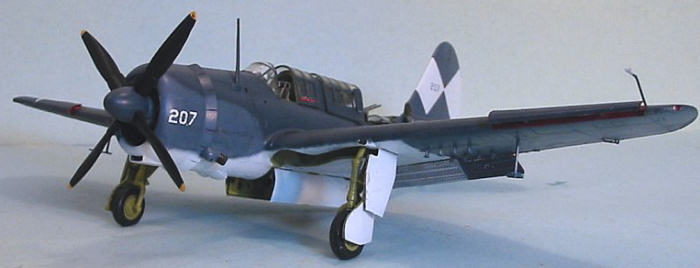
| KIT: | ProModeler 1/48 SB2C-4 Helldiver |
| KIT #: | ? |
| PRICE: | $Currently out of production |
| DECALS: | See Review |
| REVIEWER: | Tom Cleaver |
| NOTES: | Lots of Eduard photo-etch used. |

| HISTORY |
There is likely no airplane that ever served in the American armed forces that is a better example of the kind of military-industrial “boondoggle” that President Eisenhower later warned against, calling it the “military-industrial complex.” The airplane could never meet the original specifications it was created to meet, and was not much - if any - of an advance over the airplane it replaced in terms of war-fighting ability. It didn't have the range, the speed or the firepower to actually do its job. As Jim Hardy of VF-17 once told me, when they sent VB-17 off the “Hornet” in the spring of 1945, “we lost nothing in terms of offensive ability. Our Hellcats could carry more bombs further, faster, and then fight when we got there - none of which the Helldiver was capable of.” Yet even as squadrons were being downsized to 12-14 aircraft (from 36) to make room for more capable aircraft on carrier decks, Helldivers were pouring out of the factory in Columbus, Ohio, the majority of which were delivered to aircraft parks they never left. The flying ability of the airplane was thoroughly deserving of the general belief in the naval aviation community that the designation SB2C stood for “sumbitch second class.”
The
Curtiss‑Wright SB2C "Helldiver" was to be the U.S. Navy's definitive dive bomber
in what everyone in the Navy expected would be the coming war with Japan. The
winner of a 1938 design competition that required the airplane to have an
internal bomb bay capable of carrying 2,000 pounds of bombs, and an airframe
that would be able to ride a carrier elevator that was 40' x 48' ‑ the
dimensions of the coming "Essex" class of fleet carriers. This was a formidable
challenge, to design an airplane with
 sufficient performance, and
still keep its size down to such dimensions. For Curtiss, the airplane was to
be the fulfillment of all the "Helldivers" that had come before it, beginning
with the F8C in 1931, and was to be markedly superior to the Douglas SBD
"Dauntless" that was just coming off the drawing boards in late 1938.
sufficient performance, and
still keep its size down to such dimensions. For Curtiss, the airplane was to
be the fulfillment of all the "Helldivers" that had come before it, beginning
with the F8C in 1931, and was to be markedly superior to the Douglas SBD
"Dauntless" that was just coming off the drawing boards in late 1938.
The result was a short‑coupled airplane that would finally grow a huge vertical fin and rudder, as well as oversized horizontal stabilizer and elevators, in order to provide sufficient control in a fuselage as short as that in the SB2C.
Because of the looming war, the SB2C would be one of the first designs to be ordered into production "off the drawing board," before the flight of the first prototype, with 370 SB2C‑1s ordered on May 15, 1939. Due to Curtiss' commitments for the P‑40 at the Buffalo plant, a new plant in Columbus, Ohio had to be built to handle production of the Helldiver while the first prototype was being built.
At the point of the first production order, the design was far from ready for any sort of production. Wind tunnel tests revealed the original wing design had a stalling speed that was far too high for a carrier‑based aircraft, which resulted in a redesign (and concomitant delay) that increased the total wing area by 10 percent, while Handley‑Page slats were added for low‑speed controllability.
The XSB2C‑1 was rolled out on December 13, 1940, and first flew on December 18. Test pilot Lloyd Childs reported that the predicted stability problems had not been solved, though they had been somewhat mollified. The crash of the prototype in February 1941 set the program back while it was rebuilt. Testing resumed in May 1941, with a larger ‑ though not yet definitive ‑ tail. The wing failed in flight on December 21, 1941, completely destroying the prototype before it could undergo Navy trials.
The
first production SB2C‑1 rolled out on June 30, 1942. "Gremlins" in the
design slowed production and forced Curtiss toretain the early production
aircraft for further trials, with the first production airplane crashing in a
dive in January 1943, the result of wing failure. Addition of self‑sealing fuel
tanks, armor, and radar led to an increase in weight, with top speed falling
from 368 mph to 322 mph, while landing speed rose to 91 mph. At this point, the
SB2C‑1 was now underpowered with an R‑2600‑8
 providing only 1,700 h.p. for
takeoff, making its operation from even decks as large as the "Essex"class
marginal. Things got so bad that a separate "post-production" line had to be
established to modify newly‑produced aircraft; in March 1943 a second program of
modifications requiring over 800 changes to the airframe began, followed by a
third program that was only completed in November 1943 ‑ the same month that the
first Helldiver squadron entered combat.
providing only 1,700 h.p. for
takeoff, making its operation from even decks as large as the "Essex"class
marginal. Things got so bad that a separate "post-production" line had to be
established to modify newly‑produced aircraft; in March 1943 a second program of
modifications requiring over 800 changes to the airframe began, followed by a
third program that was only completed in November 1943 ‑ the same month that the
first Helldiver squadron entered combat.
There were at least three occasions when the Navy considered abandoning the Helldiver program altogether, a decision that was aborted only because of the vast investment in production resources represented by the Helldiver, as well as the lack of a suitable alternative. The fact that the Chairman of the War Production Board was also the Chairman of United Aircraft, the holding company that included Curtiss-Wright, was an additional reason for continuing the program.
The SB2C‑3 appeared in February 1944, powered by an uprated R‑2600 providing 1,900 h.p. with a 4‑bladed prop; late production aircraft had their dive flaps modified to a perforated type,which helped alleviate the buffeting and lack of directional control in a dive suffered by the SB2C‑1 and early SB2C‑3. The 4 machine gun wing armament of the SB2C‑1 was replaced by one 20mm cannon in each wing beginning with the SB2C-1C.
The SB2C‑4, which appeared in the summer of 1944 finally gave the Navy the airplane all had hoped for in 1942. With perforated dive flaps, it could perform steep, accurate dives. Unfortunately, the Helldiver was not really superior to the SBD Dauntless, which was much more controllable and a far better dive bomber.
The Helldiver was the shortest‑ranged strike aircraft in the Navy, a point driven home in the "Mission Beyond Darkness" during the First Battle of the Philippine Sea, when all SB2C‑1C and SB2C‑3 aircraft launched at extreme range against the Japanese carriers were lost due to lack of range on the return flight.
 The “divine wind” that
eventually drove the Helldiver from the flight decks first appeared on October
24, 1944. The “Kamikaze" would soon become such a threat that Admiral Nimitz
would be forced in July 1945 to withdraw his support for an invasion of the
Japanese home islands in the face of the losses the Navy had taken at Okinawa.
In the face of this threat, the carriers needed to double the size of their
fighter squadrons to provide adequate fleet defense against the suicide
attackers. The F4U‑1D and F6F‑5 fighters were now capable of flying fighter‑
bomber missions in addition to their role as fleet defense fighters, with higher
ordnance loads and better performance than the SB2C. By the Spring of 1945,
those SB2C squadrons still aboard the fleet carriers were reduced to 10 aircraft
each; when fighter squadrons were increased from 73 to 92 aircraft, the bombing
squadrons were entirely replaced, as happened to VB-17 - the original Helldiver
squadron to enter combat - aboard the “Hornet.”
The “divine wind” that
eventually drove the Helldiver from the flight decks first appeared on October
24, 1944. The “Kamikaze" would soon become such a threat that Admiral Nimitz
would be forced in July 1945 to withdraw his support for an invasion of the
Japanese home islands in the face of the losses the Navy had taken at Okinawa.
In the face of this threat, the carriers needed to double the size of their
fighter squadrons to provide adequate fleet defense against the suicide
attackers. The F4U‑1D and F6F‑5 fighters were now capable of flying fighter‑
bomber missions in addition to their role as fleet defense fighters, with higher
ordnance loads and better performance than the SB2C. By the Spring of 1945,
those SB2C squadrons still aboard the fleet carriers were reduced to 10 aircraft
each; when fighter squadrons were increased from 73 to 92 aircraft, the bombing
squadrons were entirely replaced, as happened to VB-17 - the original Helldiver
squadron to enter combat - aboard the “Hornet.”
The SB2C was credited with 44 confirmed victories in aerial combat. LT Robert B. Parker of VB‑19 was the top‑scorer, with 3 Japanese fighters shot down while operating from "Lexington" in the fall of 1944. The most successful gunners were ARM3/c E.J. Elias of VB‑14, and ARM3/c S.E. Wallace of VB‑17, with two each. 17 SB2Cs were lost to Japanese fighters during the war.
The last major mission in which the SB2C formed a significant part of the total strike force was the Tokyo strikes by Task Force 38 in February, 1945. The last significant mission flown by SB2Cs were the strikes flown by VB‑82 from the "Bennington" against the Japanese battleship "Yamato" in May 1945.
The final version of the Helldiver ‑ the SB2C‑5 ‑ flew com‑ bat missions during the Greek Civil War in 1948‑50 with the Greek Air Force, and in Vietnam in 1951‑54 with the French Aeronavale. Flotille 3F, operating from the French carrier "Arromanches" ‑ a former U.S. light fleet carrier the U.S. Navy had deemed too small to safely handle "The Beast" ‑ flew close air support missions for French forces throughout Indochina during two cruises between 1951 and 1954; their missions flown in support of the besieged garrison of Dien Bien Phu in the Spring of 1954 were not only the last combat missions flown by the SB2C, but were among the most effective dive‑bombing missions ever flown by the Helldiver.
| THE KIT |
"The
Beast" has been produced in four different kits I am aware of, the first being
an SB2C in 1/48 from Monogram that came out in 1961; this was more a toy than a
scale model, with folding wings, etc. It was also extremely inaccurate in
outline, with the wing far too narrow in chord; this was due to technology
limitations at the time which limited the percentage of area that could be
machined out of the block of steel. There was also an SB2C of uncertain
sub‑type issued in 1/72 by Aoshima in the 1960s. The
 first kit with any outline
accuracy was the 1/72 Airfix kit issued in 1969, which is still available. In
the 1970s, Modeltoy released an SB2C‑1 ‑ the only model ever made of this
sub‑type ‑ in 1/72. Most recently, Academy has released an SB2C-4 in 1/72 that
is acclaimed for accuracy and fidelity of detail. In 1/48, when Monogram
announced in 1997 that they would release an SB2C through their ProModeler line,
it was eagerly anticipated. This kit has most recently been released as an
SB2C-1 and an SB2C-4 by Accurate Miniatures; unfortunately, the SB2C-1 version
is unbuildable out of the box without major modifications and replacement of
many of the “special” parts that were included to create this sub-type.
first kit with any outline
accuracy was the 1/72 Airfix kit issued in 1969, which is still available. In
the 1970s, Modeltoy released an SB2C‑1 ‑ the only model ever made of this
sub‑type ‑ in 1/72. Most recently, Academy has released an SB2C-4 in 1/72 that
is acclaimed for accuracy and fidelity of detail. In 1/48, when Monogram
announced in 1997 that they would release an SB2C through their ProModeler line,
it was eagerly anticipated. This kit has most recently been released as an
SB2C-1 and an SB2C-4 by Accurate Miniatures; unfortunately, the SB2C-1 version
is unbuildable out of the box without major modifications and replacement of
many of the “special” parts that were included to create this sub-type.
Built out of the box, the ProModeler SB2C-4 kit is dimensionally accurate and
provides a detailed pilot's and gunner's cockpit, with photoetch perforated dive
brakes, and very nice engraved surface detail. The kit decals provide two
aircraft: a VB‑3 aircraft aboard USS "Yorktown" for the Tokyo strikes in the
tri‑color camouflage scheme, and an overall Glossy Sea Blue Helldiver from VB‑84
aboard USS "Bunker Hill" at the same time period. The bomb bay can be assembled
in the open position, the engine is sufficiently detailed for all but the
"engine nuts", and the two canopies can be posed open. The only thing one
couldn't make 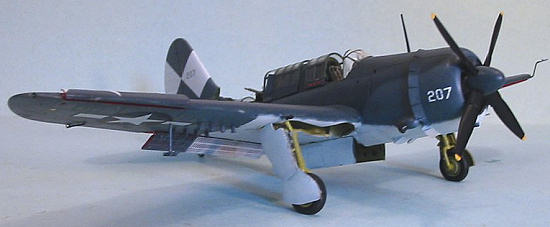 straight from the
box was a Helldiver with the rear turtleback open for deployment of the rear
guns and the flaps opened and lowered.
straight from the
box was a Helldiver with the rear turtleback open for deployment of the rear
guns and the flaps opened and lowered.
While there is currently no version of this kit by any manufacturer in production, the kit can be found on dealer's tables at model shows, and is frequently offered on eBay at reasonable prices. This is fortunate, because Eduard has just brought out three incredible photo-etch sets for the kit that provide superb cockpit detail, bomb bay detail, and the opened perforated dive flaps. These are not cheap, coming to a total of $74.85 before taxes, but for anyone who has wanted to make a truly “definitive” Helldiver, they allow anyone with the hand-eye coordination and patience to work with highly-detailed photo-etch to achieve that goal.
| CONSTRUCTION |
Having now built five of these kits, the most important thing to know regarding
assembly of the basic kit is to begin assembly with the wings, then attach them
to the fuselage halves before further assembly of the fuselage. The reason for
doing so is
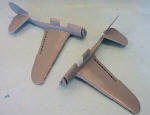 because
of the way the wing attaches to the fuselage; it is a non‑standard attachment
that really works best of one can work on the glue joint from both inside and
outside the fuselage, to press the wing into the joint and assure it is tight
and at the right dihedral angle. If you do it this way, you will not need any
gap filler anywhere on the assembly.
because
of the way the wing attaches to the fuselage; it is a non‑standard attachment
that really works best of one can work on the glue joint from both inside and
outside the fuselage, to press the wing into the joint and assure it is tight
and at the right dihedral angle. If you do it this way, you will not need any
gap filler anywhere on the assembly.
Once you have assembled the wings to the fuselage halves, you can proceed with the rest of the assembly following the kit's instructions. There are no insuperable difficulties, due to the excellent production design.
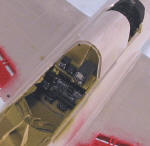 As regards the use of the Eduard photoetch, the instructions are very clear as
to what needs to be cut away, and what needs to be replaced. Since the cockpit
detail set is already pre-painted, the final result finally provides the
“busyness” of the Helldiver cockpit you see in photographs. I found in the rear
cockpit that the ammunition stowage boxes that come with the kit will look just
fine when finished, and so did not use the complicated photo-etch replacements
for these. The black box “faces” for everything in the rear cockpit really
improves the look of this area.
As regards the use of the Eduard photoetch, the instructions are very clear as
to what needs to be cut away, and what needs to be replaced. Since the cockpit
detail set is already pre-painted, the final result finally provides the
“busyness” of the Helldiver cockpit you see in photographs. I found in the rear
cockpit that the ammunition stowage boxes that come with the kit will look just
fine when finished, and so did not use the complicated photo-etch replacements
for these. The black box “faces” for everything in the rear cockpit really
improves the look of this area.
The
flaps are actually much easier than they appear at first look. Cut away
everything associated with the flaps on the kit, and then follow the
instructions to fold the photo-etch into the upper and lower flaps. These are
extremely “fiddly,” but if you take your time and apply the necessary
cyanoacrylate glue with a pin, you won't drive yourself nuts. You can set the
flaps so both upper and lower flaps are raised, or just the lower flaps are
down. Given that the upper flaps were only
 opened
fully in flight when preparing to make a dive bombing attack, the second
configuration is the more accurate. The value of leaving the upper flaps in the
down position is that you don't have to put in the really fiddly flap controls,
which are very visible in the fully-open configuration.
opened
fully in flight when preparing to make a dive bombing attack, the second
configuration is the more accurate. The value of leaving the upper flaps in the
down position is that you don't have to put in the really fiddly flap controls,
which are very visible in the fully-open configuration.
Having lowered the turtleback before on a previous kit, I decided to do it here too, because the resulting model is very striking in that configuration.
 This conversion starts with cutting off the folding area of the turtleback aft
of the gunner's cockpit before doing anything else to the fuselage halves. This
is simple, requiring use of a razor saw and a #11 X‑acto blade, and all you have
to do is follow the engraved detail.
This conversion starts with cutting off the folding area of the turtleback aft
of the gunner's cockpit before doing anything else to the fuselage halves. This
is simple, requiring use of a razor saw and a #11 X‑acto blade, and all you have
to do is follow the engraved detail.
Once you have this removed, cut off the sides from the upper section of the turtleback. Assemble that upper part and attach the canopy glass part. I used .010 plastic sheet to make thefour folding pieces of the side of the turtleback. I also used this plastic sheet to “box in” the tail surfaces.
After the model has been painted and assembled, you can attach the turtleback in the folded position, as shown in the photographs here.
| COLORS & MARKINGS |
Painting:
The cockpit was painted with Xtracrylix “Interior Green,” while the bomb bay, wheel wells and gear doors, and interior of the engine cowling, were painted with Tamiya “Yellow-green” which is a good color for Zinc Chromate. The interiors of the dive flaps and the interior area of the Handley-Page flaps were painted with Tamiya “Flat Red.”
I think the Helldiver looks best in the tri-color scheme. I used Xtracrylix “white” for the lower color, and Gunze-Sangyo “Intermediate Blue” and “Navy Blue” for the two upper colors.
Decals:
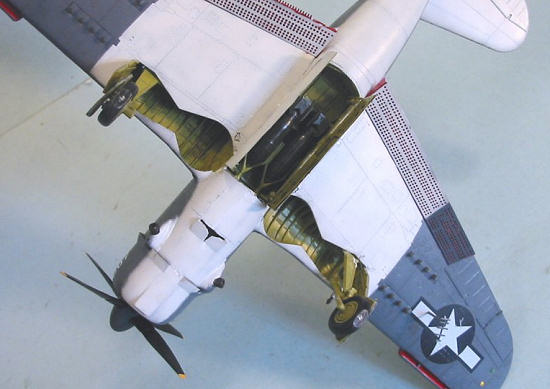 I had the old Aeromaster
sheet for “The Beast,” which included the markings for an SB2C-4 from VB-83
aboard the USS Essex in the Spring of 1945. Unfortunately, the only item of
this sheet that I ended up using was the decal for the geometric group marking
on the vertical fin and rudder. A photograph of this particular airplane can be
found on page 68 of Osprey's “Helldiver Units of World War 2,” which is
undoubtedly the photo they used. Why they couldn't figure out the size of the
national insignia, and thus provided markings that were too small, while
providing side numbers that were too big, and failing completely to provide
these numbers for the nose (a cursory examination of the photo will show all the
information you need to do this right), and missing the fact that the geometric
marking was also on the upper right wing (this comes under elementary research)
is beyond me. But then, they wouldn't have been known as “Error-master” back
when they started out if things like this didn't happen.
I had the old Aeromaster
sheet for “The Beast,” which included the markings for an SB2C-4 from VB-83
aboard the USS Essex in the Spring of 1945. Unfortunately, the only item of
this sheet that I ended up using was the decal for the geometric group marking
on the vertical fin and rudder. A photograph of this particular airplane can be
found on page 68 of Osprey's “Helldiver Units of World War 2,” which is
undoubtedly the photo they used. Why they couldn't figure out the size of the
national insignia, and thus provided markings that were too small, while
providing side numbers that were too big, and failing completely to provide
these numbers for the nose (a cursory examination of the photo will show all the
information you need to do this right), and missing the fact that the geometric
marking was also on the upper right wing (this comes under elementary research)
is beyond me. But then, they wouldn't have been known as “Error-master” back
when they started out if things like this didn't happen.
I masked off and painted the upper right wing marking, and then pieced together proper-size national insignia out of the decal dungeon and used correct-size numbers for the side number and nose marking off another Aeromaster sheet of generic numbers, which are in the right sizes.
I was using an old ProModeler kit for this project, and the decals for the myriad of stencils was unusable, so the model does not have these markings. I thought of using the markings from the decal sheet in the Accurate Miniatures SB2C-1 kit, but it turns out they're not there.
| FINAL CONSTRUCTION |
I put the bombs and the bomb crutch into the bomb bay and attached the photo-etch bomb bay doors (which do look superior to the plastic kit parts). I attached the folded turtleback and the rear cockpit weapons. I finished off by attaching the canopies in the open position, the ASB radar antennas, pitot tube and prop.
| CONCLUSIONS |
 The Helldiver may have
been a dog, but it's a cool looking beast regardless, and any collection of
historically-important American naval aircraft of the Second World War would be
severely lacking without one sitting there next to the Hellcats and Avengers.
Going so far as to spend close to four times the cost of the basic kit to get
this “definitive” model might be seen by some as “nutty,” but given that this
whole hobby can be seen as more than a little “nutty,” it comes down to
“insanity is as insanity does.” If you like the Helldiver, the end result will
be worth the effort. Not to mention that you will then have a set of perforated
dive flaps you can use on the sad-sack SB2C-1 kit to turn it into an SB2C-3, or
- if you're just a little adventurous and have access to a P-47M paddle prop,
you can make the even-easier conversion to create an SB2C-5.
The Helldiver may have
been a dog, but it's a cool looking beast regardless, and any collection of
historically-important American naval aircraft of the Second World War would be
severely lacking without one sitting there next to the Hellcats and Avengers.
Going so far as to spend close to four times the cost of the basic kit to get
this “definitive” model might be seen by some as “nutty,” but given that this
whole hobby can be seen as more than a little “nutty,” it comes down to
“insanity is as insanity does.” If you like the Helldiver, the end result will
be worth the effort. Not to mention that you will then have a set of perforated
dive flaps you can use on the sad-sack SB2C-1 kit to turn it into an SB2C-3, or
- if you're just a little adventurous and have access to a P-47M paddle prop,
you can make the even-easier conversion to create an SB2C-5.
August 2006
Review kit courtesy of my friend Terry Meisle. Photo-etch conversion sets courtesy of Eduard. Get yours direct at www.eduard.cz
If you would like your product reviewed fairly and quickly by a site that has over 300,000 visitors a month, please contact me or see other details in the Note to Contributors.